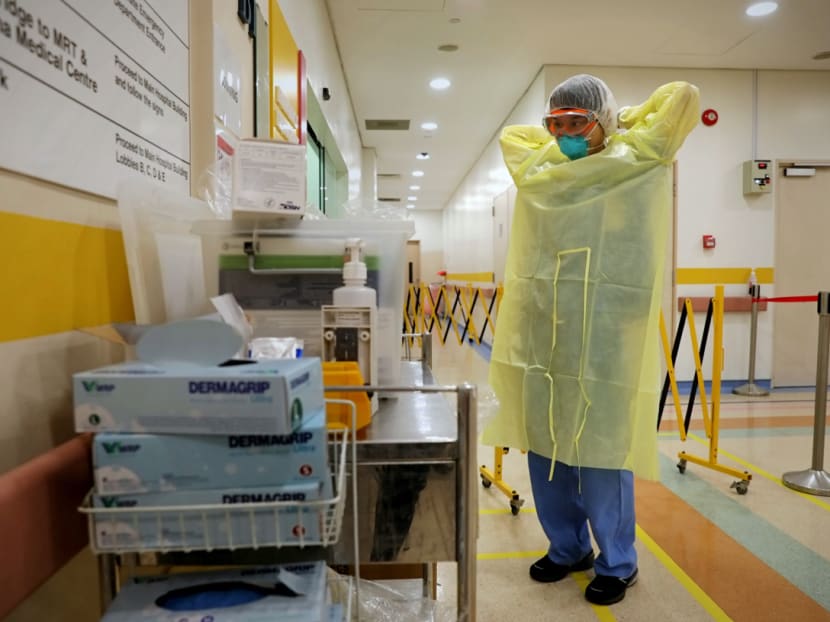S’pore to attempt the ‘impossible’ in its strategy to fight Covid-19, says Gan Kim Yong
SINGAPORE — Singapore’s strategy to combat Covid-19 is to attempt the “impossible” — by slowing the spread of the coronavirus as much as it can while avoiding the long-term impact of the pandemic, said Health Minister Gan Kim Yong in Parliament on Wednesday (March 25).

Singapore has strengthened its detection and contact tracing capabilities early on. There are currently 20 contact tracing teams from various agencies.
SINGAPORE — Singapore’s strategy to combat Covid-19 is to attempt the “impossible” — by slowing the spread of the coronavirus as much as it can while avoiding the long-term impact of the pandemic, said Health Minister Gan Kim Yong in Parliament on Wednesday (March 25).
In his ministerial statement on the nation’s Covid-19 response, Mr Gan said: “We hope that if we do it right, we can significantly slow down the growth as much as we can until the whole pandemic is over, without either a sharp peak, or a long tail.
“This may sound impossible because the two (epidemic) curves are established by academics. But impossible as it may sound, we have to try our best to do so.”
Mr Gan was referring to the global call to “flatten the curve” — a strategy mapped out by global health academics to reduce the peak of cases and stretch out the incidence of the disease so as not to overwhelm a country’s healthcare system.
One possible trajectory is if Singapore does nothing to fight the virus, the number of cases will surge, like what has happened in several cities and countries recently, said Mr Gan.
“Then our only hope is that most of the population get infected and become immune quickly, and the rate of infection starts to slow down as more become immune, or a vaccine or a cure is found, and that is when the curve starts to trend down,” he said.
But while this method may seem attractive as “you get over with it very quickly”, it carries major risks — an uncontrolled spike in the number of cases could overwhelm the healthcare system and result in many deaths, with “no turning back once you are on this track”, explained Mr Gan.
Another risk is the uncertainty of whether this herd immunity will be effective or sustained, he added.
The other pathway is the strategy advocated by many to “flatten the curve”, which would involve stringent safe distancing and other measures to slow down the infection rate.
“The number will still grow but if we do it right, we will end up with a lower peak. This is commonly known as flattening the curve. But by flattening the curve, we may actually stretch out the pandemic, meaning it will take much longer for the pandemic to be over,” he said.
Singapore — which is still at the start of the epidemic curve — now has a chance to choose neither pathways, he added.
“Singapore’s strategy will be to slow down the infection rate and maintain it at as low a level for as long as possible,” said Mr Gan.
This will help Singapore to better conduct epidemiological investigations, contact tracing and quarantining of close contacts, thus preventing further spread of the disease. Such a method can also help preserve healthcare capacity for severe cases, he said.
To this end, Singapore has strengthened its detection and contact tracing capabilities early on. There are currently 20 contact tracing teams, up from three initially, from various agencies including the Singapore Armed Forces, and are able to trace up to 4,000 contacts each day.
The new TraceTogether app by GovTech and the Health Ministry will also aid in this effort, he said.
GREATEST PENALTY IS INFECTING THOSE CLOSE TO YOU
Mr Gan reiterated that Government measures alone will not suffice.
“The daily actions of each one of us will go a long way in winning this war,” said Mr Gan, exhorting people to comply with stay-home notices and quarantine orders.
“If you violate them, there will be penalties, and the greatest penalty is that you may infect others close to you,” he said.
He stressed the importance of social responsibility and safe distancing — studies have shown a socially responsible person with Covid-19 can protect two to three others from being infected.
“It’s not just about ourselves, but those around us too, including our loved ones. For the young and healthy amongst us, we may get away with a mild cold or cough, but for our vulnerable loved ones around us, the disease may prove to be more serious,” said Mr Gan.
Singapore has also progressively imposed social distancing measures, especially for vulnerable groups such as seniors, which are of “particular concern” to MOH. These measures include the suspension of all senior activities at community centres and elsewhere, he said.
“When some MPs asked me at the last sitting whether we can resume some of these activities, I was happy to say yes, then. Now I am afraid it will be a while longer before we do that, to protect the seniors,” said Mr Gan.
He urged seniors to stay at home, unless it is for essential activities such as to work and buy food and supplies.
These measures function as extra brakes to slow the spread of Covid-19, he said.
He also emphasised the importance of psychological defence and called for Singaporeans to continue caring for others even as they maintain physical distancing.
“While we should keep a wider physical distance between ourselves and others, we need to close the emotional distance between us. As the prime minister pointed out, this is as much a psychological battle as it is a medical one,” said Mr Gan.








